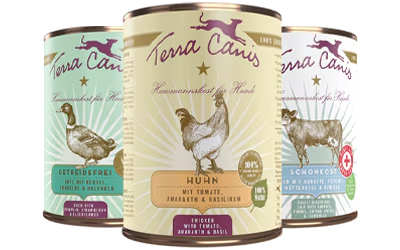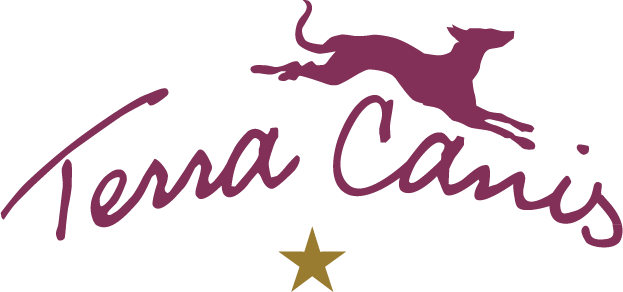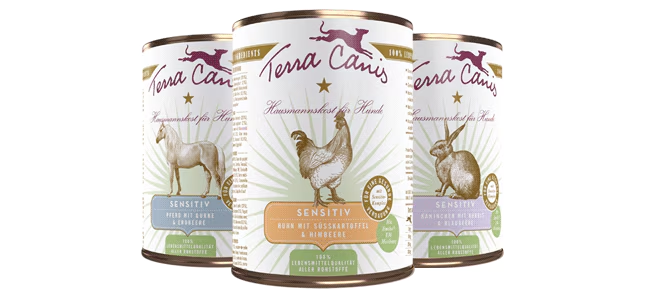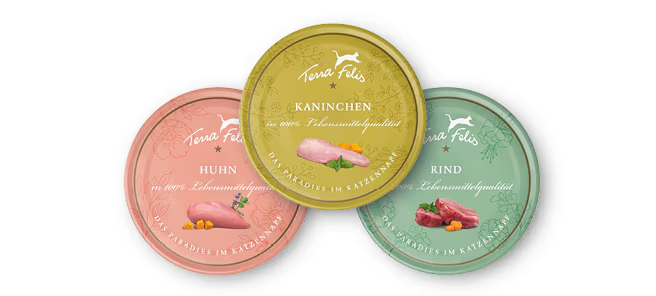The dog
A flexible meat eater
The dog has been domesticated for thousands of years. However its digestive system, unlike its appearance, has only slightly changed from that of the wolf. The wolf secures its survival by using the greatest flexibility possible in its diet, so even the wolf can often be observed switching to plant foods. Just like the wolf, the dog is a carni-omnivore, which is the description given to an animal that eats meat and vegetables.
Its food spectrum, which has developed over evolution, consists of: meat, innards and bones as main part of every meal, supplemented by plant-based elements such as herbs, grasses, roots, berries, fallen fruit as well as the plant-based contents of its prey’s stomach and intestines (may contain small traces of pre-digested grain). Feeding a dog as nature intended means mimicking this food concept in an as natural a way as possible with the best possible quality.
Lots of fresh meat – the basis of every meal
The dog as carni-omnivore gains the majority of its energy requirements from animal protein. This is why every meal needs to consist mostly of meat. In addition, the production of digestive juices in a dog is only stimulated by meat. These juices are required for digestion and are produced by gall bladder and pancreas. Fresh muscle meat, which includes heart and stomach (muscular hollow organs), provide the dog with all essential amino acids and animal fatty acids (omega-6 fatty acids), which have an important function in cell protection and metabolism. High-quality innards, such as fresh liver, also provide dogs with lots of vitamins and minerals. So you can say: the better the quality and freshness of meat, the better the quality of animal proteins and fats it contains.
Natural fibres – the secret to healthy digestion
The plant-based foods which are eaten by the wolf either directly or indirectly as part of its prey’s gastrointestinal tract can be mimicked using many kinds of healthy, high-fibre fruit, vegetables and herbs. Fresh fruit and vegetables provide valuable vitamins and minerals to fulfil the dogs nutritional requirements in the best way possible. They also provide valuable fibres which are vital for the digestion process and the entire gastrointestinal tract. These natural crude fibres help to clean the intestine and stimulate its movement.
Low grain tolerance – the dog is no horse
Moving from the stomach, food is passed on in small portions to the intestines, which is where the actual digestion and intake of nutrients takes place. In relation to its body length, the dog’s intestine is almost seven times as long. This seems impressive, but is nothing compared to the length of intestine of a herbivore, which is more than double this. These differing intestine dimensions explain the very different feeding mechanisms of a carnivore and herbivore. The wolf’s or dog’s short intestine and entire anatomy is not designed to break down and utilise complex carbohydrates like grains and starch.
The enzymes required to utilise grain are only present in small amounts in dogs. They are not capable of digesting large amounts of grain or starch. Dogs use up important energy in digesting carbohydrates which hinders other digestion processes. This can lead to abnormal fermentation which attacks the sensitive mucosal barrier in the digestive system. Damage to this natural immune system barrier has led to more and more dogs developing allergies and intolerance to grain and starch. This leads to itching, ear infections, bloatedness, restlessness, very bad breath and frequent diarrhoea. Species-appropriate feeding is grain-free or low in grain.
Natural nutrition – nature shows us how
The natural prey and the plant-based food environment of a wolf or dog in the wild is free of artificial materials and chemicals. So this is why we also look to nature when considering a dog’s nutrition. An optimum supply of nutrients can be guaranteed using vegetables, fruit, herbs and purely natural supplements (e.g. mineral clay, seaweed, pollen, eggshell, brewer’s yeast, rose hip etc.).
Unlike artificial nutritional supplements, natural vitamins, minerals and trace elements are available in the fruit and vegetables in their natural nutritional environment. They are incorporated in countless preliminary and intermediate stages as well as secondary plant substances. Vitamins and minerals can only release their entire effect within the organism when their interaction with each other is perfectly aligned.
The freshly killed prey – source of much fluid
An important aspect of a healthy diet is providing the organism with sufficient fluid. The wolf indirectly intakes large amounts of water when eating the prey it has killed. Raw meat, innards, grasses, berries and fallen fruit are made of approx. 70%–80% water. This is how the wolf intakes a large amount of the fluid it requires. Wet food has a comparable amount of fluid and therefore comes closest to natural evolutionary food. If dry food is fed, it is recommended to first soak it in water.
The belief that dry food has a cleaning effect on teeth is wrong, because canines have a classic predatory set of teeth. Dogs do not have molars with large surface areas, which plant-eaters have in order to thoroughly grind down their food. A dog’s set of teeth, with its long fanged teeth and thin chewing area, is still a predator’s set of teeth which bite and devour its prey. The pellets in dry food are not chewed thoroughly, but are normally swallowed quickly so that no cleaning effect can occur. Bones or solid dog chews are suitable for dental hygiene.
Supply of salt or sodium
Contrary to the wide-spread belief that our dogs should be fed entirely without salt, they do, by nature, require a small amount of salt. This is absorbed in the wild via the blood of their prey. The sodium it contains is vital for dogs. For this reason many Terra Canis menus contain a small amount of Andean salt – an untreated natural salt which is an excellent natural source of sodium.





